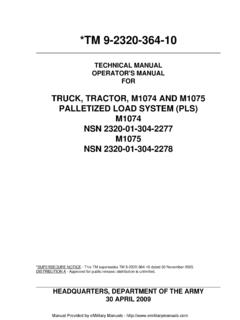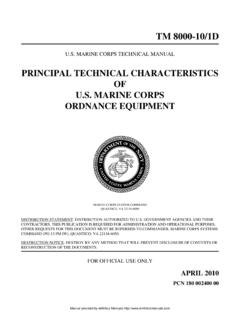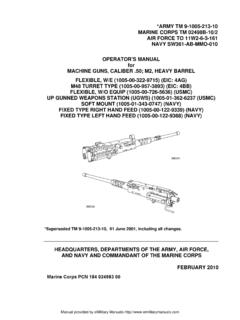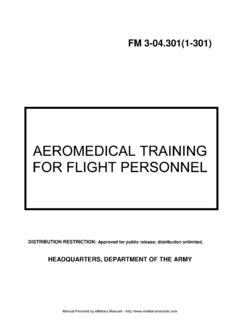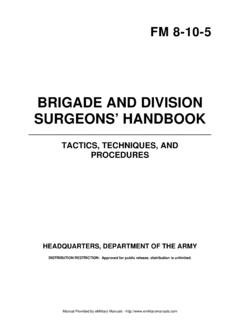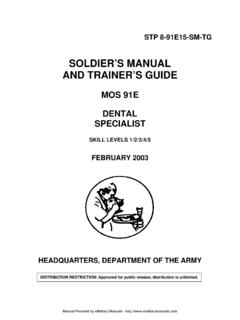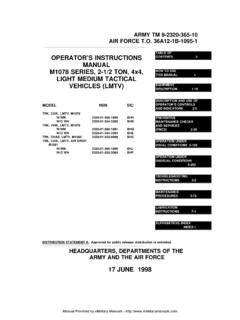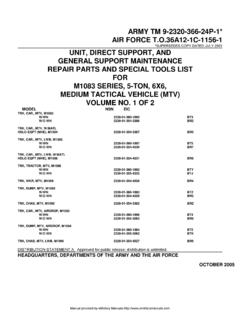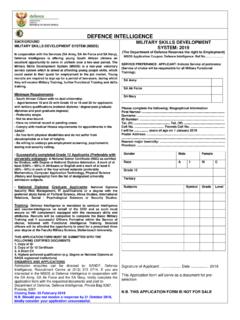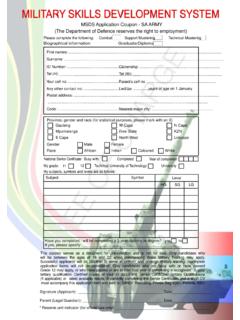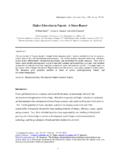Transcription of MAP READING AND LAND NAVIGATION - …
1 HEADQUARTERSFM (FM 21-26)DEPARTMENT OF THE ARMYMAP READINGANDLAND NAVIGATIONDISTRIBUTION RESTRICTION: Approved for public release; distribution is (FM 21-26)iFIELD MANUALHEADQUARTERSNo. OF THE ARMYW ashington, DC , 20 July 2001 MAP READING AND land vPart OneMAP READINGCHAPTER 1. TRAINING Approach .. Implementation .. 1-2 CHAPTER 2.. Map of Accuracy .. 2-8 CHAPTER 3. MARGINAL INFORMATION AND Information on a Military Notes .. Map Symbols .. Used on a Military 3-6 CHAPTER 4. 4-10 DISTRIBUTION RESTRICTION: Approved for public release; distribution is *This publication FM supersedes FM 21-26, 7 May States Army Military Grid Reference System .. a Point Using Grid Coordinates .. a Point Using the US Army Military GridReference Reference Grid Systems .. of Map Coordinates and 4-27 CHAPTER 5.
2 SCALE AND (Bar) Scales .. 5-11 CHAPTER 6. of Expressing Direction .. Lines .. Azimuths .. Diagram .. Resection .. 6-196-10. Polar Coordinates .. 6-20 CHAPTER 7.. Overlay .. Photograph Overlay .. 7-3 CHAPTER 8. AERIAL With Maps .. of Film .. and Titling Determination .. of Designation of Photograph 8-178-10. 8-18FM (FM 21-26)iiiPagePart TwoLAND NAVIGATIONCHAPTER 9. NAVIGATION EQUIPMENT AND of Handling .. a Methods .. Positioning 9-12 CHAPTER 10. ELEVATION AND RELIEF10-1. 10-110-2. Methods of Depicting 10-110-3. Contour 10-210-4. Types of Slopes .. 10-510-5. Percentage of 10-810-6. Terrain Features .. 10-1110-7. Interpretation of Terrain Features .. 10-1710-8. Profiles .. 10-20 CHAPTER 11. TERRAIN ASSOCIATION11-1. Orienting the Map.
3 11-111-2. Locations .. 11-611-3. Terrain Association Usage .. 11-711-4. Tactical 11-911-5. Movement and Route Selection .. 11-1211-6. NAVIGATION Methods .. 11-1411-7. Night NAVIGATION .. 11-18 CHAPTER 12. MOUNTED land NAVIGATION12-1. 12-112-2. Navigator's Duties .. 12-112-3. Movement .. 12-112-4. Terrain Association NAVIGATION .. 12-312-5. Dead Reckoning NAVIGATION .. 12-612-6. Stabilized Turret Alignment 12-712-7. Combination NAVIGATION .. 12-8 CHAPTER 13. NAVIGATION IN DIFFERENT TYPES OF TERRAIN13-1. Desert Terrain .. 13-113-2. Mountain Terrain .. 13-413-3. Jungle Terrain .. 13-613-4. Arctic Terrain .. 13-9FM Urban Areas .. 13-10 CHAPTER 14. UNIT SUSTAINMENT14-1. Set Up a Sustainment Program .. 14-114-2. Set Up a Train-the-Trainer Program .. 14-214-3. Set Up a land NAVIGATION 14-2 APPENDIX A.
4 FIELD A-1 APPENDIX B. MAP FOLDING TECHNIQUES .. B-1 APPENDIX C. UNITS OF MEASURE AND CONVERSION FACTORS .. C-1 APPENDIX D. JOINT OPERATIONS GRAPHICS .. D-1 APPENDIX E. EXPORTABLE TRAINING MATERIAL .. E-1 APPENDIX G. M2 G-1 APPENDIX H. ADDITIONAL H-1 APPENDIX I-1 APPENDIX J. GLOBAL POSITIONING SYSTEM .. J-1 APPENDIX K. PRECISION LIGHTWEIGHT GLOBAL POSITIONINGSYSTEM RECEIVER .. References-1 INDEX ..Index-1FM purpose of this field manual is to provide a standardized source document forArmywide reference on map READING and land NAVIGATION . This manual applies to everysoldier in the Army regardless of service branch, MOS, or rank. This manual also containsboth doctrine and training guidance on these subjects. Part One addresses map READING andPart Two, land NAVIGATION . The appendixes include a list of exportable training materials, amatrix of land NAVIGATION tasks, an introduction to orienteering, and a discussion of severaldevices that can assist the soldier in land proponent of this publication is the US Army Infantry School.
5 Submit changes tothis publication on DA Form 2028 (Recommended Changes to Publications and BlankForms) directly to CommandantUS Army Infantry SchoolATTN: ATSH-IN-S3 Fort Benning, GA this publication states otherwise, masculine nouns and pronouns do not referexclusively to ONEMAP READINGCHAPTER 1 TRAINING STRATEGYThis manual is in response to an Armywide need for a new map readingand land NAVIGATION training strategy based on updated doctrine. Thischapter describes and illustrates this approach to teaching these APPROACHI nstitution courses are designed to prepare the soldier for a more advanced duty position inhis unit. The critical soldiering skills of move, shoot, and communicate must be trained,practiced, and sustained at every level in the schools as well as in the unit. The map readingand land NAVIGATION skills taught at each level are critical to the soldiering skills of the dutyposition for which he is being school-trained.
6 Therefore, they are also a prerequisite for acritical skill at a more advanced A soldier completing initial-entry training must be prepared to become a teammember. He must be proficient in the basic map READING and dead reckoning After completing the Primary Leadership Development Course (PLDC), a soldiershould be ready to be a team leader. This duty position requires expertise in the skills of mapreading, dead reckoning, and terrain A soldier completing the Basic NCO Course (BNCOC) has been trained for thesquad leader position. Map READING and land NAVIGATION at skill level 3 requires developmentof problem-solving skills; for example, route selection and squad tactical At skill level 4, the soldier completing the Advanced NCO Course (ANCOC) isprepared to assume the duty position of platoon sergeant or operations NCO.
7 Planningtactical movements, developing unit sustainment, and making decisions are the importantland NAVIGATION skills at this Officers follow similar progression. A new second lieutenant must have masteredmap READING and land NAVIGATION skills, and have an aptitude for dead reckoning and terrainassociation.(1) After completing the Officer Basic Course, the officer must be prepared to assumethe duties and responsibilities of a platoon leader. He is required to execute the orders andoperations of his commander. Map READING and land NAVIGATION at this level requiredevelopment of the problem-solving skills of route selection and tactical movement.(2) After completing the Officer Advanced Course, the officer is prepared to assume theduties and responsibilities of a company commander or primary staff officer. Thecommander must plan and execute operations with full consideration to all aspects ofnavigation.
8 The staff officer must recommend battlefield placement of all administrative,logistical, and personnel resources. These recommendations cannot be tactically soundunless the estimate process includes a detailed analysis of the area of operations. This abilityrequires expertise in all map READING and NAVIGATION skills to include the use of nonmilitarymaps, aerial photographs, and terrain analysis with respect to both friendly and enemyFM The commander/staff officer must plan and execute a program to develop the unit'strain-the-trainer program for land A program of demonstrated proficiency of all the preceding skill levels to thespecified conditions and standards is a prerequisite to the successful implementation of abuilding-block training approach. This approach reflects duty position responsibilities inmap READING and land NAVIGATION .
9 An understanding of the fundamental techniques of deadreckoning or field-expedient methods is a basic survival skill that each soldier must developat the initial-entry level. This skill provides a support foundation for more interpretiveanalysis at intermediate skill levels 2 and 3, with final progression to level 4. Mastery of allmap READING and land NAVIGATION tasks required in previous duty positions is essential for thesequential development of increasingly difficult abilities. This building-block approach issupported by scope statements. It is part of the training doctrine at each level in theinstitutional training environment of each Exportable training and instructor support/certification packages are being developedbased upon the updated map READING and land NAVIGATION field manual. Innovative trainingdevices and materials are being developed for use in the institution, ROTC regions, and thefield.
10 (See Appendixes E and H.) IMPLEMENTATIONA mandatory core of critical map READING and land NAVIGATION tasks and a list of electiveswill be provided to each TRADOC service school and FORSCOM professional developmentschool. Standardization is achieved through the mandatory core. Exportable training materialis made available to support Armywide leaders plan to brief and enforce all safety regulations established by local rangecontrol. They coordinate the mode of evacuation of casualties through the appropriatechannels. They review all installation safety regulations. Unit leaders must complete athorough terrain reconnaissance before using an area for land NAVIGATION training. Theyshould look for dangerous terrain, heavy trafficked roads, water obstacles, wildlife, andtraining 2 MAPSC artography is the art and science of expressing the known physicalfeatures of the earth graphically by maps and charts.
